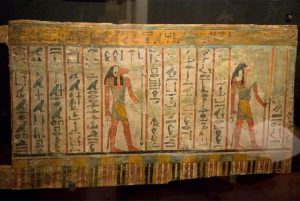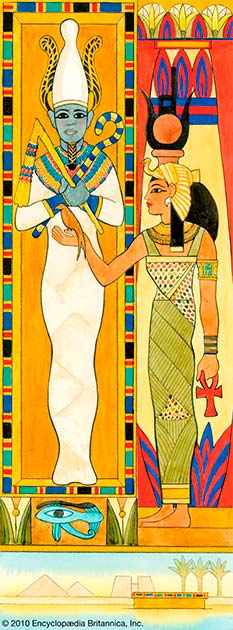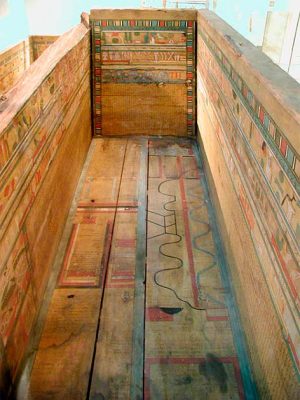Exposing the Mysterious Universe of the Egyptian Coffin Writings

One of the most fascinating discoveries of ancient Egypt was the discovery of the Egyptian Coffin Texts, a collection of spellbinding funerary spells and incantations inscribed on coffins, sarcophagi, and other funerary objects.
Written during the Middle Kingdom period, these texts offer a comprehensive guide for the deceased on their journey through the afterlife, giving us a glimpse at the importance of religion, social hierarchy, morality, and literacy in ancient Egyptian society. Ongoing translations of this discovery have helped historians unlock a wealth of knowledge about ancient Egypt’s fascinating civilization and enduring legacy.

Fragment of coffin text ‘Book of the Dead’, Egypt. (CC BY-SA 3.0)
The Coffin Texts: A Personal Guide to the Afterlife
The discovery of the Egyptian Coffin Texts unveiled a trove of over 1,000 ancient funerary spells and incantations, etched onto coffins, sarcophagi, and other burial relics during the Middle Kingdom period (2055-1650 BC). These mystical texts were ultimately written as celestial guides, created to safeguard the deceased on their journey through the afterlife.
Unlike other funerary practices held in ancient Egypt during this period, the Egyptian Coffin Texts embraced a broader audience and were not limited to only the elite. Middle-class individuals and their families were able to commission priests and scribes to inscribe these powerful texts on their burial vessels to ensure a safe passage to the afterlife. There was also a more extensive array of spells and magical incantations written in the Coffin Texts compared to earlier funerary texts.
While the enigmatic origin of the Egyptian Coffin Texts remains a mystery, it is believed that a group of priests and scribes, well-versed in hieroglyphs and the religious practices of ancient Egypt at the time, were responsible for their initial creation.
One unique aspect of the Coffin Texts is their hieroglyphic script, which was designed specifically for the eyes of the deceased rather than the living.

The rectangular wooden coffin of the Overseer of the Storehouse, Khety, with Coffin Text spells on the panels is of a type known from the mid-12th Dynasty on. (CC0)
Although they were eventually succeeded by the more intricate and expansive Book of the Dead during the New Kingdom period (1550-1070 BC), the Coffin Texts were used as a plentiful source of inspiration for future funerary literature.
From Preservation to Ascension: The Diverse Themes of the Coffin Texts
The Coffin Texts contain several diverse themes, including safeguarding the body, reviving the senses, shielding the soul, the judgment of the dead, ascending to divinity, invoking deities, and performing offerings and sacrifices. Spells to preserve the deceased’s physical form were used to halt decay and ensure that the body remained unblemished on its journey to the afterlife. Then, spells to awaken the senses, including those for opening the eyes, ears, and mouth, were used to enable the deceased to fully perceive and travel to the afterlife.
To safeguard the soul, the Coffin Texts contained spells to shield it from harm and prevent annihilation in the afterlife. Spells concerning the judgment of the dead guaranteed fair evaluations and recognition of good deeds during the deceased’s life. Some tombs also contained spells assisting the deceased’s transformation into a divine being to elevate their status in the afterlife, allowing them to join the celestial pantheon.

Egyptian gods Isis (right) and Osiris were revered in ancient Egyptian religion and as a means of protection for the deceased. They have been depicted on in the Coffin Texts. (Encyclopaedia Britannica)
Spells summoning revered deities, such as Osiris, Isis, Horus, and Ra, were also woven into the Coffin Texts, seeking the gods’ protection over the deceased. Many also contained instructions for offerings and sacrifices, which would provide sustenance for the departed in the afterlife and showcase their devotion to the gods.
Ultimately, the Coffin Texts served as a comprehensive roadmap for the deceased on their otherworldly journey in all capacities.
Decoding Ancient Beliefs: The Significance of the Egyptian Coffin Texts
The Egyptian Coffin Texts were an essential discovery for historians researching ancient Egypt and its religious beliefs. These texts offer a significant understanding of the convictions and customs of ancient Egyptian civilization, and help to uncover the prominence of the afterlife and the involvement of deities in the cycle of death and rebirth. They also provide information on societal structure and the significance of social standing in ancient Egypt.
The use of spells and charms for safeguarding the deceased’s physical form illustrates the emphasis placed on physical appearance and the corporeal body in ancient Egyptian culture. The guidelines for offerings and sacrifices to the deities also illustrate the significance of religion and divine beings in everyday life. They convey not only the belief in an afterlife, but also the necessity to supply sustenance for the departed as they navigate the afterlife.

Map of the netherworld painted on panels of Middle Kingdom coffin, Egypt. 12th Dynasty, 1985-1795 BC. (British Museum/CC)
The Coffin Texts also illustrate the concept of judgment following death and the value of virtuous actions during one’s life. This implies that morality and ethical conduct were highly esteemed in ancient Egyptian civilization.
In terms of language, the Coffin Texts exemplify the use of hieroglyphs and the progression of written language in ancient Egypt. Their content displays the refinement of the Egyptian language during the Middle Kingdom era and the increasing significance of literacy in ancient Egyptian culture. Today, they serve as invaluable resources for scholars delving into the depths of ancient Egyptian language and communication.
Egypt’s Legacy in Divine Offerings
The Egyptian Coffin Texts reveal the importance of religion, social hierarchy, morality, and developing literacy in ancient Egyptian society. Our current understanding of ancient Egyptian culture and language would not be nearly as encompassing as it is without the discovery of these fascinating texts.
Today, the Coffin Texts continue to be studied and translated, providing ongoing opportunities for scholars to expand their knowledge of ancient Egyptian religion, culture, and society. Through ongoing research and translation efforts, we can continue to deepen our understanding of ancient Egyptian civilization and its enduring legacy in the modern world.